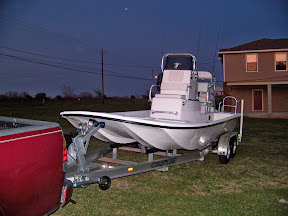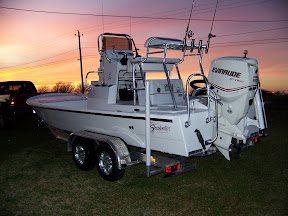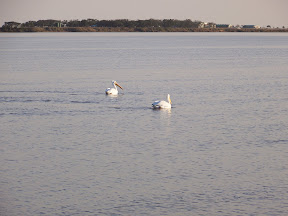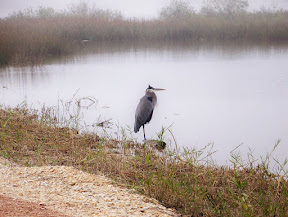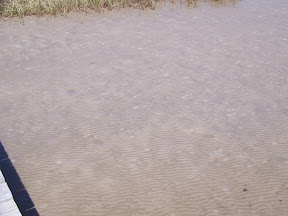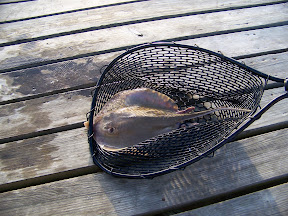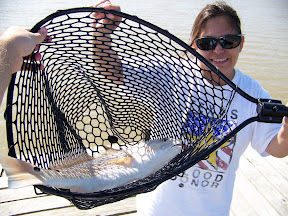Let me start out by saying that we did not catch many fish. The wind was really blowing, and it limited my options. It is the Captain's responsibility to make sure his passengers are safe, and considering that I have only had my new boat a couple of weeks, I did not think it was a good idea to test its limits with passengers on board. I admit, I was probably overly cautious, but as they say, "better safe than sorry". In talking to a few other fisherman afterwards, I learned that we actually did quite well -- better than most, in fact.
On a positive note, I did get a chance to do some exploring. I discovered a few promising fishing spots that I will definitely be re-visiting as the conditions improve. I also expanded my knowledge of the bay. The more I know where to go and where to avoid, the less stressful and the more enjoyable boating becomes.
Having a GPS/Sonar unit really helped. Before this incredibly useful piece of gear was installed, I was essentially driving blind. I had to try to derive the depth and bottom composition by taking cues from the contours of the surrounding landscape. Lets face it, coastal ground does not have many contours - that combined with the very shallow water creates a very real threat of running aground.
Fortunately, with the help of my new electronics, we did not run aground. In fact I was able to successfully navigate a few places that were hereto before unaccessible. I also learned that my new boat can run very shallow. It is very cool to be able to get to places that other boats don't dare to go. After my trolling motor is installed next week, I will be able to get even shallower.
Shallow is good - you can see the fish, and cast ahead of them. This is much more effective than randomly casting and hoping something grabs your lure.

This photo shows just a shallow spot. I was able to position the boat just outside of this
slough (pronounced 'sloo'), and wait for the fish to come to me with the incoming tide. This slough was one of an intricately connected set of bayous that traversed the
Spartina marsh grasses. The rising tide would wash through the bayous, filling the back ponds. Bait would get pulled into the system, were
redfish would wait in ambush. I was able to see this action by standing on my boat's polling platform, then cast way up into the mouth of the slough were the redfish were waiting. We caught several small redfish this way, and one nice keeper.
The tides are a very important element in this kind of fishing. The moving tide affect fish behavior in predictable ways. It also effects were you can and were you should not take the boat, otherwise you might find yourself stranded when the tide runs out. Fortunately for us, we had a strong tide that rose in the morning, and went back out at night. The rising tide allows you to get into the shallow back-water places that you would otherwise avoid. The fish slowly move into the shallow areas with the flood, chasing bait. On an outgoing tide, its best to place the boat at the mouth of a lake or bay, where all of the hungry fish will be waiting for the bait to be delivered to their open mouths.
The moving tide also creates eddies, and ambush places where big
spotted seatrout like to hang out.
We caught a nice one here by parking the boat down current from this point. There was scattered oyster beds and a long sand bar that created a strong swirl in the water. I could imagine a big trout waiting for a small
mullet or
shad to get caught in the eddy. By casting ahead of the sand bar and letting the current take the bait into the swirl, my suspicions were confirmed - he took the bait. Now he's in my freezer.
I have a
power pole installed on my boat, which is a great innovation that lets you sink a fiberglass pole down into the mud or sand at the push of a button. This effectively parks the boat in place. The boat will swing around the pole in the direction of the wind and current. Then by alternately pulling up and pushing down the power pole, you can slide along the current, stopping at intervals along the way. It is very stealthy too, because you don't need to start up the big motor, or even the trolling motor. Used in conjunction with the trolling motor, this could be a formidable weapon in the hunt for fish. I'm going to see if I can get a remote switch for my power pole mounted on my trolling motor, to do just that.
Having a shallow running boat lets you get into the grassy places where redfish like to hang out. Here is a grassy spot with an oyster reef running along side of it. It looked very promising, but did not pan out this time. When the redfish are feeding in the grass beds, I will be back.

I keep a couple of four to six foot sections of pvc pipe on board. If I see an underwater obstruction, like a pipe or pole, I can use a pipe to mark the spot. This will hopefully keep me or anyone else from running over it, and damaging their boat. Having the pvc on board has another benefit. When I wanted to get a feel for the bottom composition, I would grab a pvc pipe, and push the end into the bottom. If it was soft and mushy, I knew it was mud. If it was soft and firm, I knew it was sand or clay. It it was hard and crunchy, I knew it was a reef. Its good to know where the reefs are, because they usually hold fish. At first glance, this spot looks like it would be a very muddy bottom. Surprisingly, the pvc pipe test revealed that it was a flourishing oyster reef. These are the best spots, because they are not obvious, and so are often over-looked by other fisherman. I'll come back here, too.

So, my mental map of Carancahua Bay is starting to fill out. My goal is to identify about ten spots with potential, then keep checking those spots to see how the weather and water conditions affect my fishing success. This past weekend I learned that strong wind and murky water do not make for good fishing. All of the fish I caught were shallow. The birds were widely scattered, and were not revealing any fish. I did manage to find bait, however. Where the bait is, the fish are - so I was on the right track. By locating bait, I have also confirmed that bait has returned to our waters. This is a very good sign that the bite should start picking up soon.













